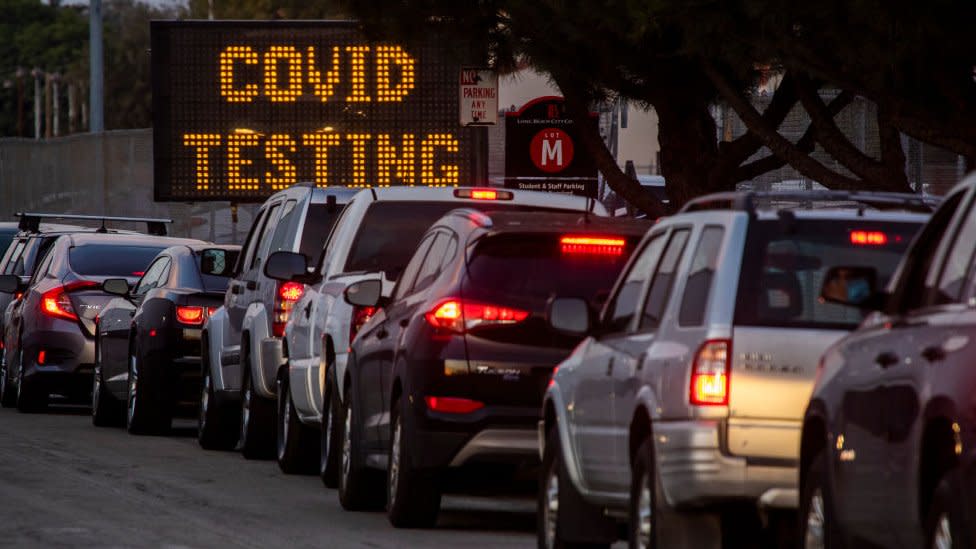
California was praised for acting quickly to contain the coronavirus last spring. Now, more than 31,000 people have died from the virus in the state. What went wrong?
California was the first to issue a home stay order across the state, and experts at the time predicted that the pandemic would peak here in April, with less than 2,000 lives lost.
But since November, deaths have increased by more than 1,000%. In Los Angeles alone, nearly 2,000 people died this week.
Improvised morgues have been set up across the state, ICUs are full, oxygen is being rationed and ambulance crews have been instructed not to transport those who are unlikely to survive the night because the hospitals are full.
Disneyland, which has been closed since March, is now being transformed into a major vaccination center, along with Dodger Stadium, in hopes of controlling what has become a super outbreak.
Why is California in such a dire situation in Covid?
“Fatigue,” says Dr. Neha Nanda, from the Keck School of Medicine at the University of Southern California. “It is multifaceted, but fatigue is a big reason.”
Southern California and Los Angeles are the hardest hit regions in California and the United States at the moment.


Local and state officials begged Californians not to make plans for the Thanksgiving holiday until the New Year. But even strict mandates here are often not fulfilled.
Many companies have collapsed, the film industry is dormant. Productions that get the green light are often forced to close again due to coronavirus outbreaks on set.
And most schools in California have been closed since March 13, with children isolated at home on computers, often with their parents at work or trying to work with their children on overloaded Wi-Fi networks.
And like most places, Covid-19 hit the Los Angeles poor harder.
Dr. Heidi Behforouz, medical director for Housing for Health in Los Angeles County, says she thinks Los Angeles is a city used to tolerating extreme inequality in a country that does the same.
“We are kind of pulled by your own country – we have a very individual mind and it’s hard to think about giving up what we feel is our right to do what we want,” she says.
Although Covid-19 can infect anyone, it is definitely more cruel to the poor than the rich.
For each case of Covid in Beverly Hills, there are six times more in Compton. While two people from Bel Air died, more than 230 people lost their lives in eastern Los Angeles working class.

And now, the virus is spreading through the vast population of homeless people in Los Angeles. People who live in Los Angeles are used to passing by tens, hundreds or even thousands of people who live on the streets every day.
At the beginning of the pandemic, they were largely spared from infection – probably because they are as isolated as the population.
Cities and counties are using trailers and motels to house positive Covid homeless people.
The Union Rescue Mission on Skid Row in Los Angeles is usually full of guests and residents excited to dine. But in these pandemic days, it is quiet, with most of its isolated residents quarantined.

Behind the building, a fabric tent designed to house the most vulnerable women on the streets is now a field hospital filled with men with Covid, attended by doctors and nurses covered from head to toe with the now familiar protective equipment.
“Covid’s situation is the worst of all and this is the most horrible battle we have ever entered into,” said Rev. Andy Bales, who heads the mission.
“It’s like playing chess with a monster genius – every move we make is overcome by Covid.”
At the beginning of the pandemic in March, Bales was relieved that the homeless population appears to have been spared the coronavirus.
But then, in April, a dear member of the mission team, Gerald Shiroma, died of the virus. He was 56 years old.
Mr. Shiroma had overcome addiction to meth and a life on the street to become sober and was a beloved driver on the mission.
“He was a wonderful guy,” said Bales. “Everyone here loved him.”
As the exhausted frontline medical workers continue their struggle, the fear is that things will continue to get worse.
As the virus spreads, it is likely to mutate more than we know, says Dr. Neha Nanda.
“Perhaps the bigger the place, the more variation,” she says.
